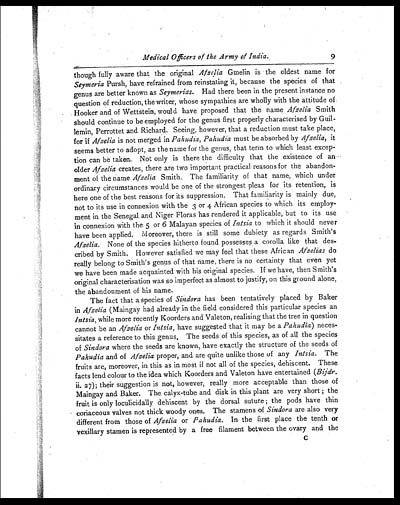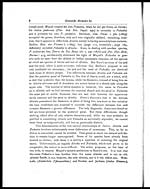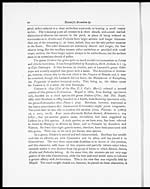Medicine - Institutions > Army health reports and medical documents > Scientific memoirs by medical officers of the Army of India > Part XII, 1901 > 1 - On the characters and relationships of Afzelia (Smith)
(19) Page 9
Download files
Individual page:
Thumbnail gallery: Grid view | List view

Medical Officers of the Army of India.
9
though fully aware that the original Afzelia Gmelin is the oldest name for
Seymeria Pursh, have refrained from reinstating it, because the species of that
genus are better known as Seymerias. Had there been in the present instance no
question of reduction, the writer, whose sympathies are wholly with the attitude of
Hooker and of Wettstein, would have proposed that the name Afzelia Smith
should continue to be employed for the genus first properly characterised by Guil-
lemin, Perrottet and Richard. Seeing, however, that a reduction must take place,
for if Afzelia is not merged in Pahudia, Pahudia must be absorbed by Afzelia, it
seems better to adopt, as the name for the genus, that term to which least excep-
tion can be taken. Not only is there the difficulty that the existence of an
older Afzelia creates, there are two important practical reasons for the abandon-
ment of the name Afzelia Smith. The familiarity of that name, which under
ordinary circumstances would be one of the strongest pleas for its retention, is
here one of the best reasons for its suppression. That familiarity is mainly due,
not to its use in connexion with the 3 or 4 African species to which its employ-
ment in the Senegal. and Niger Floras has rendered it applicable, but to its use
in connexion with the 5 or 6 Malayan species of Intsia to which it should never
have been applied. Moreover, there is still some dubiety as regards Smith's
Afzelia. None of the species hitherto found possesses a corolla like that des-
cribed by Smith. However satisfied we may feel that these African Afzelias do
really belong to Smith's genus of that name, there is no certainty that even yet
we have been made acquainted with his original species. If we have, then Smith's
original characterisation was so imperfect as almost to justify, on this ground alone,
the abandonment of his name.
The fact that a species of Sindora has been tentatively placed by Baker
in Afzelia (Maingay had already in the field considered this particular species an
Intsia, while more recently Koorders and Valeton, realising that the tree in question
cannot be an Afzelia or Intsia, have suggested that it may be a Pahudia ) neces-
sitates a reference to this genus. The seeds of this species, as of all the species
of Sindora where the seeds are known, have exactly the structure of the seeds of
Pahudia and of Afzelia proper, and are quite unlike those of any Intsia. The
fruits are, moreover, in this as in most if not all of the species, dehiscent. These
facts lend colour to the idea which Koorders and Valeton have entertained (Bijdr.
ii. 27); their suggestion is not, however, really more acceptable than those of
Maingay and Baker. The calyx-tube and disk in this plant are very short; the
fruit is only loculicidally dehiscent by the dorsal suture; the pods have thin
coriaceous valves not thick woody ones. The stamens of Sindora are also very
different from those of Afzelia or Pahudia. In the first place the tenth or
vexillary stamen is represented by a free filament between the ovary and the
C
Set display mode to: Large image | Zoom image | Transcription
Images and transcriptions on this page, including medium image downloads, may be used under the Creative Commons Attribution 4.0 International Licence unless otherwise stated. ![]()
| Permanent URL | https://digital.nls.uk/75004740 |
|---|
| Shelfmark | IP/QB.10 |
|---|---|
| Additional NLS resources: | |




